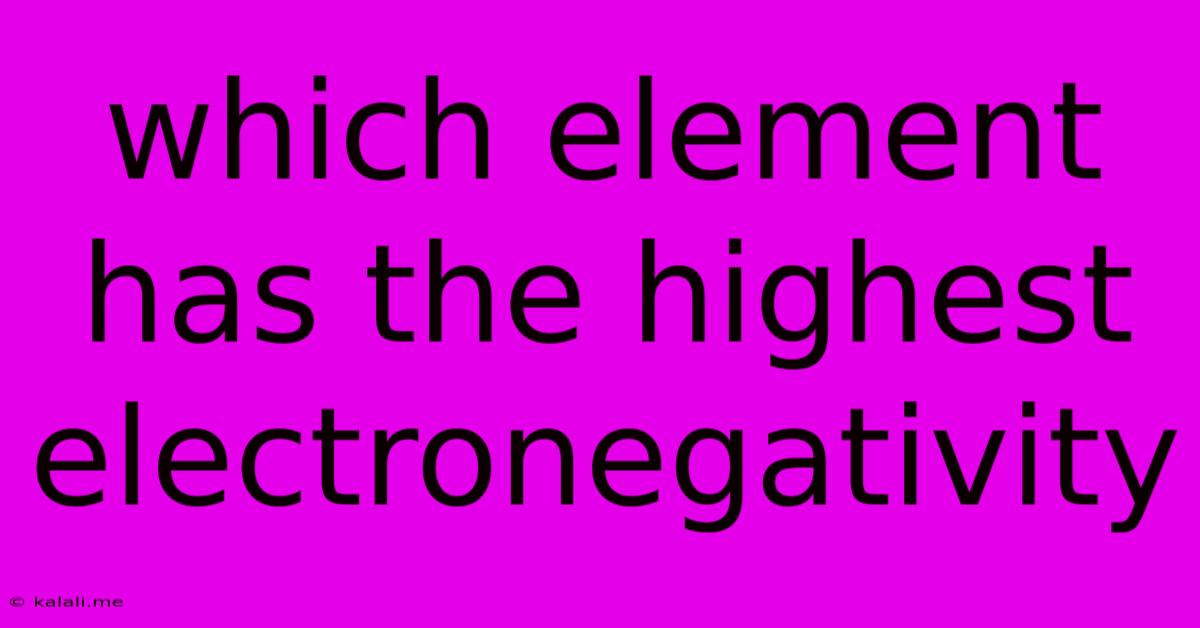Which Element Has The Highest Electronegativity
Kalali
Jun 12, 2025 · 3 min read

Table of Contents
Which Element Has the Highest Electronegativity? Understanding Electronegativity and its Trends
Electronegativity, a crucial concept in chemistry, describes an atom's ability to attract shared electrons in a chemical bond. Understanding electronegativity helps predict the type of bond formed (ionic, covalent, or polar covalent) and the properties of resulting molecules. But which element reigns supreme in this atomic tug-of-war? This article will explore electronegativity, its trends in the periodic table, and definitively answer the question: which element possesses the highest electronegativity?
Understanding Electronegativity: A Closer Look
Electronegativity isn't a directly measurable quantity like mass or charge. Instead, it's a relative property, meaning it's compared to other elements. Several scales exist to quantify electronegativity, with the most commonly used being the Pauling scale. On this scale, higher numbers indicate greater electronegativity. The value reflects several factors, most importantly:
- Nuclear Charge: A greater number of protons in the nucleus exerts a stronger pull on electrons.
- Atomic Radius: Smaller atoms have electrons closer to the nucleus, experiencing a stronger attractive force.
- Shielding Effect: Inner electrons shield outer electrons from the full nuclear charge, reducing the effective nuclear charge experienced by the valence electrons.
Periodic Trends in Electronegativity:
Electronegativity generally increases across a period (from left to right) and decreases down a group (from top to bottom) in the periodic table. This trend is directly linked to the factors mentioned above. Moving across a period, the nuclear charge increases while the atomic radius remains relatively constant, leading to a stronger pull on electrons. Moving down a group, the atomic radius increases significantly, increasing the distance between the nucleus and valence electrons, thus weakening the attraction.
The Champion of Electronegativity: Fluorine
The element with the highest electronegativity is fluorine (F). Its small atomic radius and high nuclear charge, combined with a relatively small shielding effect, result in an exceptionally strong attraction for electrons in a chemical bond. This makes fluorine highly reactive, readily forming strong bonds with other elements. Its electronegativity value on the Pauling scale is approximately 4.0.
Other Highly Electronegative Elements:
While fluorine holds the top spot, other elements also exhibit high electronegativity:
- Oxygen (O): Oxygen has a high electronegativity (approximately 3.5 on the Pauling scale), making it crucial in many biological and chemical processes.
- Nitrogen (N): Nitrogen also boasts significant electronegativity (approximately 3.0), contributing to its role in forming strong bonds in various compounds.
- Chlorine (Cl): Chlorine, located in the same group as fluorine, exhibits high electronegativity (approximately 3.0), though lower than fluorine due to its larger atomic size.
Electronegativity's Importance in Chemistry:
Understanding electronegativity is vital for predicting molecular properties:
- Bond Polarity: The difference in electronegativity between two bonded atoms determines the polarity of the bond. A large difference leads to a polar covalent bond, while a very large difference results in an ionic bond.
- Molecular Geometry: Electronegativity influences the shape of molecules by affecting the distribution of electron density.
- Chemical Reactivity: Highly electronegative elements tend to be more reactive, readily participating in chemical reactions to gain electrons and achieve a stable electron configuration.
In conclusion, fluorine decisively holds the title for the element with the highest electronegativity. Understanding this property and its periodic trends provides invaluable insight into the behavior and properties of chemical bonds and molecules.
Latest Posts
Latest Posts
-
Which Of The Following Statements Is True About Algorithms
Jun 13, 2025
-
Which Of The Following Is Not True About Minerals
Jun 13, 2025
-
Divide And Conquer Vs Dynamic Programming
Jun 13, 2025
-
Communication Between Two People Is Called
Jun 13, 2025
-
Groups Of Cells That Are Similar In Structure And Function
Jun 13, 2025
Related Post
Thank you for visiting our website which covers about Which Element Has The Highest Electronegativity . We hope the information provided has been useful to you. Feel free to contact us if you have any questions or need further assistance. See you next time and don't miss to bookmark.